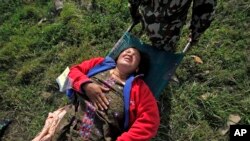Humanitarian operations in earthquake-stricken Nepal are aggressively increasing to assist millions of survivors throughout the country, including those in hard to reach remote areas in need of food, water, shelter, medical care and other life-saving essentials.
Most of the aid so far has been distributed to Nepal’s earthquake victims in and around the capital, Kathmandu. People living close to the epicenter of the quake, in remote towns and villages along the foothills of the Himalayas, have been virtually cut off from aid.
Landslides and rock falls have destroyed roads, putting these areas out of reach. The only way to reach these rural inhabitants is by helicopter. Relief supplies now are being flown in and distributed to the survivors of this disaster.
The International Federation of Red Cross and Red Crescent Societies reports it is increasingly focusing its humanitarian operations on these outlying areas. The organization says its large network of volunteers is carrying out assessments of needs.
Red Cross disaster and crisis specialist Christine South says volunteers are providing first aid and distributing goods such as tarpaulins, oral rehydration salts and aqua tabs. She says people in some of these villages are in desperate need.
“Ninety percent of the houses destroyed. People living in wet conditions with the rains having started, with very few covers, tarpaulins. So, that is very much our priority is to get more assistance into those areas. Clearly the needs in those outlying districts are huge in terms of water and sanitation and in terms of shelter, food and medicines; but, our focus clearly at the present time has been shelter with the distributions of tarpaulins and actually also looking at the sanitation needs," said South.
South says things are really starting to move. She says the congestion at the airport is easing and more relief flights are coming in. The U.N. Children’s Fund reports one of its cargo planes carrying 30 tons of relief supplies arrived in Kathmandu Friday morning. The World Food Program flew in 50 metric tons of high energy biscuits Thursday and is in the process of distributing food to some of the hardest hit districts of Nepal.
WFP spokeswoman Elisabeth Byrs tells VOA all the aid agencies have been working at full capacity to assist the quake victims from the start. She says she is stung by criticism from those who say the U.N. and other agencies have been slow since the beginning in getting aid to the victims.
“It is always the same problem when a disaster strikes and it is true that the U.N. cannot do miracles. It takes time. You have logistic challenges…I think that given the condition we can see on the ground, it is a huge effort, which has been done by all U.N. agencies, including WFP of course. We have 2,000 metric tons of food in country, in warehouses. Now, it is a problem of logistics. Now, we have a helicopter doing as many rotations as possible given the meteorological conditions, the rain, the mist, the landslides," said Byrs.
The United Nations recently launched an inter-agency appeal for $415 million to provide life-saving assistance for millions of survivors of this devastating quake over the next three months. To date, it has received $53 million.












